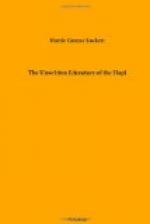So the “long gowns” were thrown over the cliff, and that was that. Certain dissentions and troubles had come upon them, and some crop failures, so they attributed their misfortunes to the anger of the old gods and decided to stamp out this new and dangerous religion. It had taken a strong hold on one of their villages, Awatobi, even to the extent of replacing some of the old ceremonies with the new singing and chanting and praying. And so Awatobi was destroyed by representatives from all the other villages. Entering the sleeping village just before dawn, they pulled up the ladders from the underground kivas where all the men of the village were known to be sleeping because of a ceremony in progress, then throwing down burning bundles and red peppers they suffocated their captives, shooting with bows and arrows those who tried to climb out. Women and children who resisted were killed, the rest were divided among the other villages as prisoners, but virtually adopted. Thus tenaciously have the Hopi clung to their old religion—noncombatants so long as new cults among them do not attempt to stop the old.
There are Christian missionaries among them today, notably Baptists, but they are quite safe, and the Hopi treat them well. Meantime the old ceremonies are going strong, the rain falls after the Snake Dance, and the crops grow. The Hopi realize that missionary influence will eventually take some away from the old beliefs and practices and that government school education is bound to break down the old traditional unity of ideas. Naturally their old men are worried about it. Yet their faith is strong and their disposition is kindly and tolerant, much like that of the good old Methodist fathers who are disturbed over their young people being led off into new angles of religious belief, yet confident that “the old time religion” will prevail and hopeful that the young will be led to see the error of their way. How long the old faith can last, in the light of all that surrounds it, no one can say, but in all human probability it is making its last gallant stand.
These Pueblo Indians are very unlike the nomadic tribes around them. They are a sedentary, peaceful people living in permanent villages and presenting today a significant transitional phase in the advance of a people from savagery toward civilization and affording a valuable study in the science of man.
Naturally they are changing, for easy transportation has brought the outside world to their once isolated home. It is therefore highly important that they be studied first-hand now for they will not long stay as they are.
III. HOPI SOCIAL ORGANIZATION
* * * * *
=Government=
In government, the village is the unit, and a genuinely democratic government it is. There is a house chief, a Kiva chief, a war chief, the speaker chief or town crier, and the chiefs of the clans who are likewise chiefs of the fraternities; all these making up a council which rules the pueblo, the crier publishing its decisions. Laws are traditional and unwritten. Hough[5] says infractions are so few that it would be hard to say what the penalties are, probably ridicule and ostracism. Theft is almost unheard of, and the taking of life by force or law is unknown.




